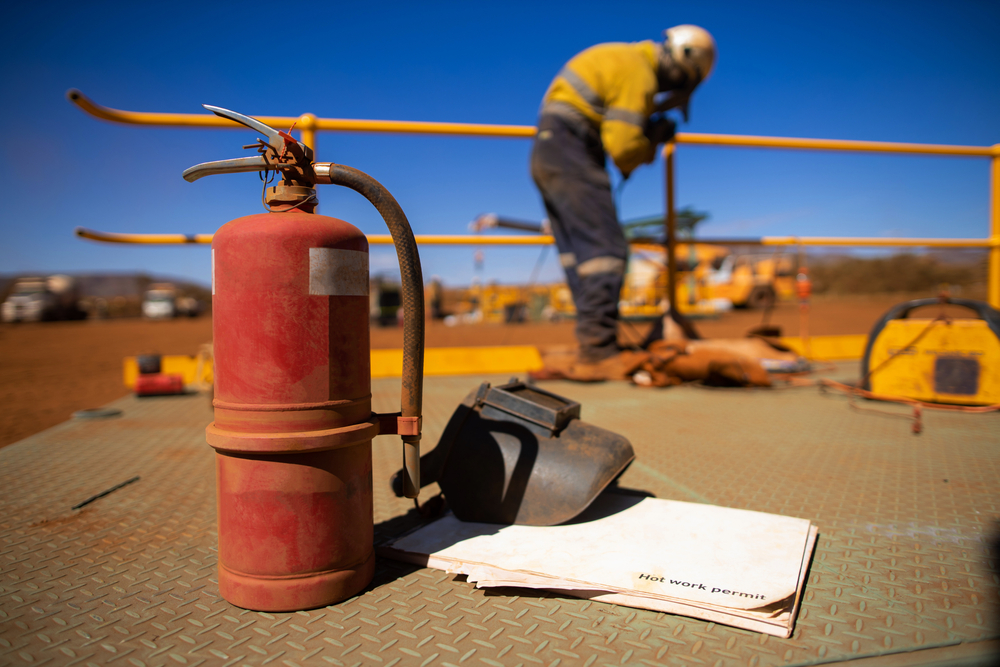Back to Basics is a weekly feature that highlights important but possibly overlooked information that any EHS professional should know. This week, we examine the different types of workplace fires and how to prevent them.
Fire is a hazard that can affect any workplace and have devastating consequences. Thankfully, small fires can often be extinguished using portable fire extinguishers.
However, not all fires can be extinguished the same way. Depending on the fuel of the fire, it can be classified into one of five categories. The category determines the type of extinguisher that’s effective against that specific fire type.
Once you learn about all the fire types and how to put them out, you’ll be able to act quicker in case of an emergency.
Class A
The most common type of fire is a Class A fire. Class A fires are often the result of igniting fabrics, wood, paper, trash, or plastics. Lighting a match or knocking over a candle, for example, can create a Class A fire. Class A fires can be extinguished with water, foam, dry powder, and wet chemical extinguishers.
Class B
Class B fires aren’t as common as Class A fires, but they’re more dangerous. They involve flammable liquids and gases such as gasoline, paint, alcohol, petroleum grease, propane, methane, and butane. According to the Fire Equipment Manufacturers’ Association, water shouldn’t be used to put out a Class B fire, as it can make the fire worse. For liquid fires, carbon dioxide (CO2), foam, and dry powder extinguishers are the right choices, as they remove the oxygen supply feeding the fire. Dry powder is most effective for flammable gases.
Class C
Electrical equipment is related to Class C fires. Plugging too many things into an electrical outlet can start an electrical fire. Class C fires can also start due to the malfunction of faulty appliances, old wiring, and even worn-out breaker boxes. They often occur inside old homes and industrial settings, although they’re still possible in new buildings. Ideally, the first step to extinguish a Class C fire is to disconnect the equipment responsible for the fire from the power source, if safe to do so. Then, if possible, use a CO2 or dry powder extinguisher to put the fire out. Refrain from using water or any other chemical that may conduct electricity, as it can exacerbate the flames or result in electrical shock.
Class D
Some metals can be ignited. Class D fires occur when those metals burn. The possibility of that happening inside a home is low, but inside a laboratory or any building processing combustible metals, it’s a real risk. Titanium, potassium, magnesium, aluminum, and sodium are flammable under the right conditions. Class D fires can occur if these metals are exposed to extreme heat. Moreover, fires may spread and get more intense if water or foam is used on them. Only dry powder should be used to extinguish a Class D fire, as powder absorbs the heat from the fire.
Class K
There’s a fire type that’s a real hazard inside kitchens. It’s called a Class K fire. Class K fires are produced when liquids such as cooking oils or animal or vegetable fats get ignited. Leaving a pan unattended for too long is one of the causes of this type of fire. Trying to extinguish a Class K fire with water is a big mistake, as it may cause the flames to spread. Instead, turn off the heat, remove the fire from the heat source, and use a wet chemical extinguisher if needed. Wet chemical extinguishers produce a foam over the burning oil, preventing oxygen from fueling it.
As you now know, understanding the different types of fires and appropriate extinguishing methods for each type is critical to yours and your employees’ safety. You never know when a fire might start, and having the right knowledge will make all the difference. Become familiar with each type of extinguisher, and remember what type of fire each is used for. That way, you’ll be prepared to make the right decision to protect yourself and others in the event of a fire.

Business and Learning Resources (BLR), a division of Simplify Compliance, LLC, is an industry-leading knowledge provider with more than 40 years of experience in human capital management, environmental, health, and safety; learning and development; and legal markets. BLR® provides innovative education solutions designed to help businesses deliver consistent training, achieve compliance, and maximize efficiencies in employee workflows, resulting in measurable performance and financial improvements.

